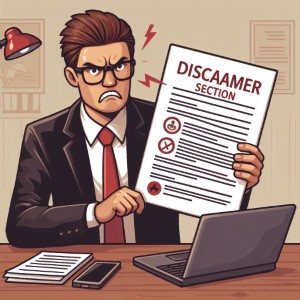Rethinking the Disclaimer Section in Your Resume: A Space for Creativity
In the digital age, the inclusion of a disclaimer section in resumes has been a topic of debate. Does it truly serve a purpose in the modern hiring landscape, or is it an unnecessary addition that eats up valuable space in your document?
The disclaimer section, often added to safeguard personal information or clarify the views expressed, tends to consume crucial space that could otherwise be utilized to showcase your skills and experiences creatively.
Recruiters increasingly view disclaimers as redundant and a waste of precious space. It’s essential to recognize that this section doesn’t add substantial value to your candidacy but, instead, takes away from highlighting your qualifications and achievements.

Commonly Used Disclaimers:
- “The information provided is accurate to the best of my knowledge.”
- “References available upon request.”
- “I certify that all information provided is true and complete.”
- “Opinions expressed are my own and not those of my employer.”
These generic disclaimers not only occupy space but also fail to offer any unique insight into your abilities or personality.
Instead of using the disclaimer section, candidates can creatively utilize this space to include a compelling summary, highlight key achievements, or incorporate a unique section that sets them apart from the competition.
Join our Resume Development Workshop to discover effective strategies for maximizing the impact of your resume. Learn how to eliminate unnecessary sections like disclaimers and instead focus on showcasing your unique value proposition.
Register now at 🔗Resume Development Workshop to transform your resume into a powerful marketing tool. Don’t let a disclaimer section hinder your chances—unlock your resume’s potential and secure your professional success!
FAQs
Q1: Why do resumes traditionally include a disclaimer section? The disclaimer section was once common to protect personal information and clarify statements. However, its relevance in today’s resumes is debatable.
Q2: Is a disclaimer necessary to safeguard my information? Most hiring processes involve privacy policies and legal agreements, making the disclaimer section redundant in resumes.
Q3: What’s the downside of including a disclaimer in my resume? It consumes valuable space that could be used to highlight skills, achievements, and qualifications relevant to the job.
Q4: Can’t a disclaimer section add credibility to my resume? In most cases, recruiters focus more on content related to your qualifications and experiences rather than disclaimers.
Q5: How can I use the space allocated for a disclaimer more effectively? Consider utilizing that space for a unique summary, showcasing achievements, or presenting a distinct section that sets you apart.
Hashtags
- #ResumeDebate
- #SpaceUtilization
- #ModernResumes
- #CreativeContent
- #ProfessionalInsights
- #ResumeTips
- #JobSearch
- #CareerStrategy
- #ResumeWorkshop
- #ProfessionalEdge
![]()


